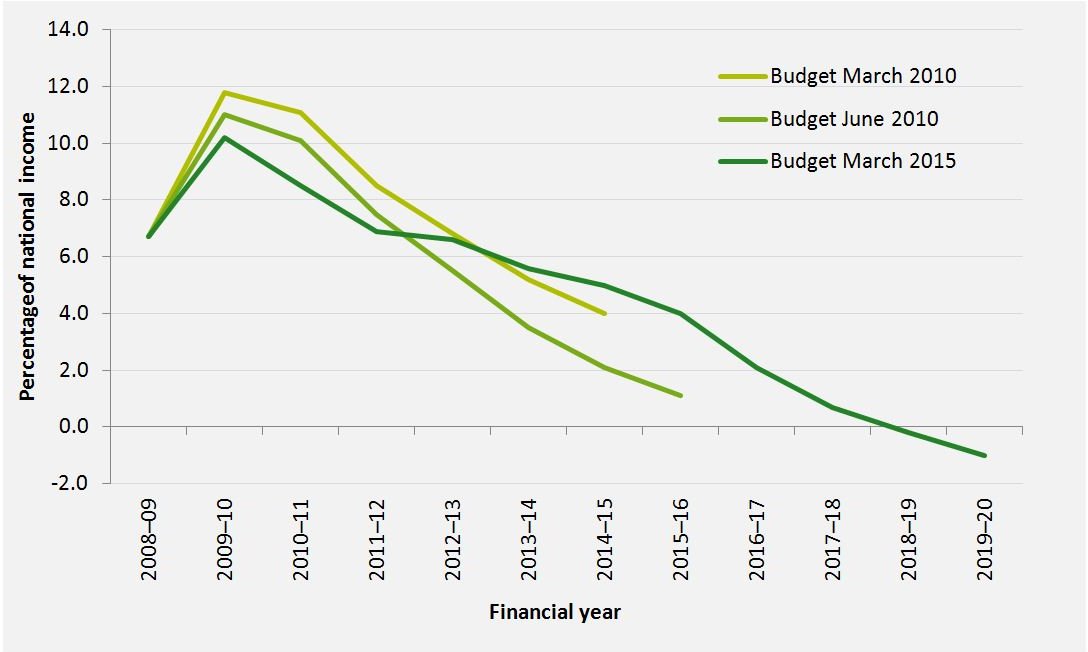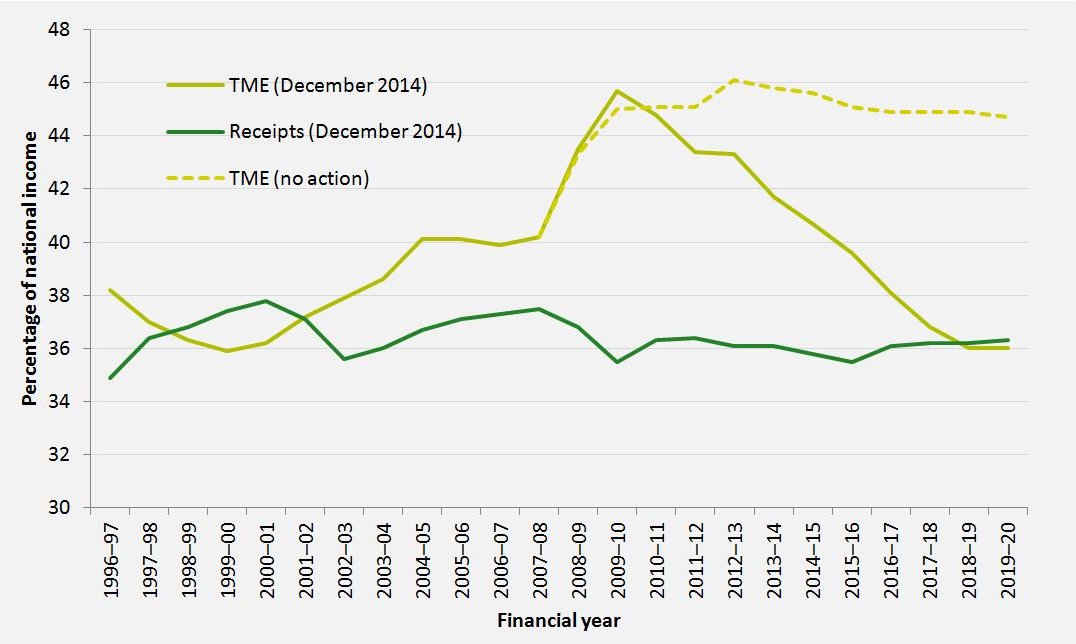
Public Finances
Deficit cut by half but next government will still have a big job to do
A hole in the public finances opened up from 2008, after the financial crisis and associated recession. As national income fell, tax receipts fell even faster. Spending that was fixed in cash terms shot up as a share of national income. In 2009–10 government borrowing was 10.2% of national income. Worse still, most of the resulting increase in borrowing was thought to reflect a permanent hole in the public finances, i.e. borrowing that would not disappear as the economy recovered. With no policy action, debt would have been on an unsustainable path.
As a share of national income, by 2014–15 the deficit was half that in 2009–10, and the latest forecasts suggest that the government will be running a surplus of 0.3% of national income by 2019–20. However, as shown in Figure 1, things have not gone completely to plan. Back in June 2010 the Coalition expected borrowing to fall much more quickly after 2011–12 and the deficit this year is projected to be more than twice as high as was forecast in June 2010.
Figure 1. Public Sector Net Borrowing – as forecast in 2010 and 2015 [get the data for this graph]

Note: A major accounting change affected measures of borrowing and national income between 2010 and December 2014. The black dotted line presents the figures on the old basis, whereas the black solid line contains the most up to date numbers.
Borrowing in this parliament has been greater than expected due to weak economic growth with much of this additional weakness thought to be permanent rather than temporary. In response, rather than adding to the consolidation in this parliament, the government lengthened the period of consolidation, pencilling in extra spending cuts in the last years of the forecast horizon. Whereas the last Labour government had planned a seven year consolidation amounting to 5.8% of national income, the latest plan is for a more ambitious consolidation, lasting ten years and amounting to 9.9% of national income.
The coalition government set out plans for spending up to 2019–20 in the 2014 Autumn Statement. Figure 2 shows the profile and composition of the fiscal consolidation if these plans are delivered. 11.5% of the tightening is planned to come from tax increases (see Taxes for details of changes to the tax system), 11.2% from cuts to welfare spending (see Benefits) and 77.3% from cuts to other public spending (see Public Spending). By April 2015 just over half of the total tightening is forecast to have been implemented. However, the tax increases are frontloaded while many of the spending cuts are backloaded, so that 92.1% of the former will have been implemented by April 2015, compared to only 56.1% of the latter.
Figure 2. Timing and composition of the fiscal remedy (consistent with the 2015 Budget) [get the data for this graph]

One rationale for the large proportion of the tightening coming from spending cuts is shown in Figure 3. The recession resulted in a rapid increase in spending as a share of national income, and in the absence of policy action it would have remained at a historically high level. The level of taxes relative to national income was much less affected, although underlying receipts continue to be weak relative to pre-crisis levels. The currently planned fiscal consolidation is forecast to reduce public spending as a share of national income to its lowest level in at least the last fifty years (though not very different to its level at the end of the 1990s), and tax to around the level it was in 2004–05.
A more detailed discussion of how the public finances have evolved over this parliament and the policy stance adopted by the coalition government is available in Chapter 1 of the 2015 IFS Green Budget. Also available here are presentations by IFS researchers looking at the impact of the announcements made at the 2015 Budget.
[sk1]http://election2015.ifs.org.uk/article/budget-2015-analysis
Figure 3. Revenues and spending – with and without policy action [get the data for this graph]

Whoever wins the election may choose to change the size, profile or composition of the fiscal tightening. This briefing note describes the fiscal rules announced by the three main UK parties, and the implications for how borrowing, tax and public spending plans might look different after the election. This analysis will be updated once party manifestos have been published in 2015.
IFS election 2015 publications
Briefing notes
Daniel Chandler and Richard Disney, 'Extending Right to Buy: risks and uncertainties', Institute for Fiscal Studies: 24 April 2015, IFS briefing note BN171, election briefing note 2015 No. 12, ISBN: 978-1-909463-89-9
Rowena Crawford, Carl Emmerson, Soumaya Keynes and Gemma Tetlow, 'Post-election austerity: parties' plans compared', Institute for Fiscal Studies: 23 April 2015, IFS briefing note BN170, election briefing note 2015 No. 11, ISBN: 978-1-909463-882
Rowena Crawford, Carl Emmerson, Soumaya Keynes and Gemma Tetlow, 'Fiscal aims and austerity: the parties’ plans compared', Institute for Fiscal Studies: 19 December 2014, IFS briefing note BN158, election briefing note 2015 No. 1, ISBN: 978-1-909463-72-1
The 2015 IFS Green Budget
Carl Emmerson and Gemma Tetlow, Public finances under the coalition, The 2015 IFS Green Budget, Carl Emmerson, Paul Johnson and Robert Joyce (eds.), February 2015
Rowena Crawford, Carl Emmerson and Gemma Tetlow, Public finances: a dicey decade ahead?, The 2015 IFS Green Budget, Carl Emmerson, Paul Johnson and Robert Joyce (eds.), February 2015
Observations
Carl Emmerson, Paul Johnson and Soumaya Keynes, Would Labour increase taxes by over £3,000 for every working household?, Institute for Fiscal Studies: 30 March 2015, Observation
Gemma Tetlow, Cutting the deficit: five years down, four to go?, Institute for Fiscal Studies: 27 March 2015, Observation
David Phillips, Scotland’s fiscal position: an update in light of the OBR’s March Forecasts, Institute for Fiscal Studies: 19 March 2015, Observation
David Phillips, Scotland's fiscal position improves in 2013-14 but this is set to stall as oil price falls bite, Institute for Fiscal Studies: 11 March 2015, Observation
Rowena Crawford, Carl Emmerson, Soumaya Keynes and Gemma Tetlow, How do the parties' fiscal targets compare?, Institute for Fiscal Studies: 19 September 2014, Observation (note: the numbers in this Observation have been updated in briefing note BN158 above)
Useful resources
A presentation given at the IFS Budget briefing 2015 addressed the overall implications of the Chancellor's Budget announcements for public finances.
OBR data bank contains long-run public finances data.
Presentation and chapter discussing the principles of fiscal rules.
OBR working paper explaining the evolution of the public finances since 2007–08.



